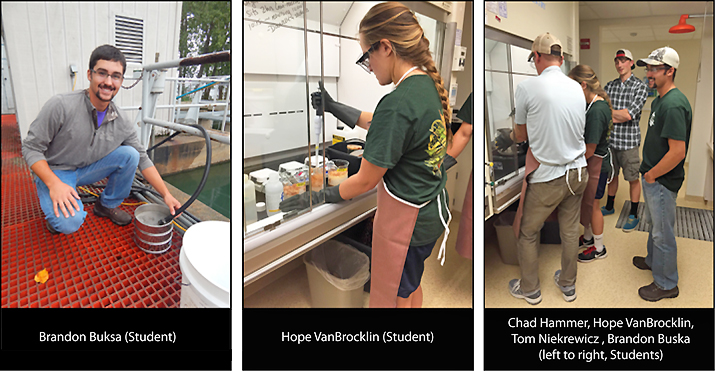Faculty Grants Foster Student Research Opportunities in Earth and Environmental Science | SUNY Plattsburgh
Two SUNY Plattsburgh environmental science faculty members received grant money this semester that will fund research related to pollution and conditions in Lake Champlain.
Dr. Eric Leibensperger, assistant professor of environmental science, received $66,767 toward research to help scientists study how the lake’s conditions relate to climate change through the use of a data buoy.
Dr. Danielle Garneau, associate professor of environmental science, was awarded $71,279 to continue research on microplastics in Lake Champlain and area wildlife.
The financial support for both ventures will create hands-on research opportunities for students this summer and beyond.
“Our department in particular strives to get our students out in the field doing real-world research and this is a good example of that,” Leibensperger said.
The grants are funded by the National Oceanic and Atmospheric Administration through the Lake Champlain Sea Grant.
Mapping Microplastics
For Garneau, the grant will help her and a team of students collect and analyze samples of microplastics from the City of Plattsburgh Wastewater Pollution Control Plant and associated wildlife as these particles move up the food chain.
One subset of the plastics is microbeads, which were commonly used in toothpastes and facial scrubs before they were banned nationwide by the Microbead-Free Waters Act of 2015.
A series of sieves, placed at the last stage of processing at Plattsburgh’s wastewater treatment plant, collects debris in the treated water before it leaves the facility and enters the lake.
The researchers at SUNY Plattsburgh use a specialized machine housed in the SUNY Plattsburgh chemistry department to analyze and categorize the microplastics as fibers, fragments, beads or pellets, film or foam.
Garneau has been collecting samples from the Plattsburgh wastewater plant since 2012 in a project started in partnership with Dr. Sherri Mason, a professor of chemistry at SUNY Fredonia who has been studying the effects of microplastics in the Great Lakes.
That project was part of a SUNY Innovative Instructional Technology grant created to leverage the use of technology and distance mentoring to grow the scope of experiential research opportunities for students across the SUNY system.
To date, 13 SUNY Plattsburgh students have participated in the microplastic pollution research.
Moving forward, Garneau and the students will be expanding surveys to include other wastewater plants including one in Burlington, Vt.
The team has detected microplastics in fish and cormorants in samples collected from the New York State Department of Environmental Conservation and Vermont Fish and Wildlife.
Additionally, the team has been collecting data on tiny pieces of rubber called nurdles found in bodies of water. Using samples that were collected during long-term lake monitoring research and efforts through the Lake Champlain Research Institute, they are mapping the distribution and abundance of nurdles throughout Lake Champlain.
Establishing a ‘Climate Normal’ for Lake Champlain
Leibensperger’s research will help establish a baseline knowledge of the normal conditions of Lake Champlain so he can see how changes in weather influence the lake, which will make the effects of climate change on the lake measurable.
“We haven’t observed the lake well enough to know what’s normal and how conditions change year to year,” Leibensperger said.
This spring, SUNY Plattsburgh junior William Pierce and Leibensperger, with assistance from SUNY Plattsburgh’s Lake Champlain Research Institute, will install a data buoy in Lake Champlain southeast of Valcour Island where it will collect meteorological data from the lake during the spring, summer and fall of each year.
“Our goal is to keep it (the project) going as long as we can,” Leibensperger said.
Live-Steaming Data
The solar-powered buoy features a weather sensor that measures conditions in the air above the water. A string of thermometers attached to the bottom of the buoy will measure the temperature at different depths of the lake. And a sensor on the bottom of the buoy will measure water acidity, conductivity and dissolved oxygen.
Through a cell modem inside the buoy, the data will be continuously transmitted to a website, which will be accessible to the public as part of the Vermont Monitoring Cooperative Database.
The Lake Champlain Research Consortium has provided an additional $5,000 in support for Leibensperger's project, which will help fund the student research participation component.
Pierce, who is double majoring in environmental science and geology, will analyze the data collected by the buoy this summer and student research will continue through fall 2017.
Sharing Data and Outreach
The data from the buoy will inform the research of area scientists including Dr. Timothy Mihuc, SUNY Plattsburgh professor of environmental science and director of the Lake Champlain Research Institute, who has been collecting biological samples from Lake Champlain since the early ‘90s.
The National Weather Service will benefit as well, Leibensperger said.
“They’re really excited to have the data.”
SUNY Plattsburgh Sea Grant Extension Specialist Mark Malchoff will share the findings of both faculty members’ projects with the public through outreach programs as the research progresses.
“A really important part is taking what we learn and sharing it with the public,” Leibensperger said.
Garneau has already given presentations on her research to 30 City, a community forum in Plattsburgh; a local Boy Scout troop; Rotary International and members of New York State Master Teachers.
Student Research Photos

News
